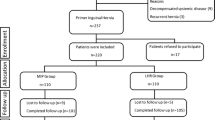Abstract
The optimal operation technique for groin hernia repair has not been established. This study evaluates the long-term recurrence rate and perioperative complications after posterior inguinal mesh hernia repair using a gridiron incision described by Frans Ugahary. A retrospective analysis was performed of the medical records of 366 patients who underwent Ugahary hernia repair. Operative results and perioperative morbidity were evaluated retrospectively. Follow-up was done by clinical examination. The main outcome measure was recurrence rate at a mean follow-up of 2 years. Of the 386 groin hernia repairs, 263 hernia repairs were examinated in the outpatient clinic. The overall recurrence rate was 6.5% with a mean follow-up of 2 years, and 10.1% of the patients had minor complications. This retrospective study demonstrates that the repair according to Ugahary is a safe technique for operating on groin hernia. However, the procedure is difficult to reproduce in nonexpert hands. This technique must be compared to other inguinal hernia operation techniques in the near future.

Similar content being viewed by others
References
Beets GL, Oosterhuis KJ, Go PMNYH, Baeten CGMI, Kootstra G (1997) Longterm follow-up (12–15 years) of a randomized controlled trial comparing Bassini-Stetten, Shouldice, and high-ligation with narrowing of the internal ring for primary inguinal hernia repair. J Am Coll Surg 185:365–70
Danielsson P, Isacson S, Hansen MV (1999) Randomised study of Lichtenstein compared with Shouldice inguinal hernia repair by surgeons in training. Eur J Surg 165:49–53
Hay JM, Boudet MJ, Fingerhut A, Poucher J, Hennet H, Habib E, Veyrieres M, Flamant Y (1995) Shouldice inguinal hernia repair in the male adult: the gold standard? A multicenter controlled trial in 1578 patients. Ann Surg 22:719–27
Cunningham J, Temple WJ, Mitchell P, Nixon JA, Preshaw RM, Hagan NA (1996) Cooperative hernia study. Pain in the postrepair patient. Ann Surg 224:598–602
Welsh DRJ, Alexander MAJ (1993) The Shouldice repair. Surg Clin North Am 73:451–69
Liem MS, van Vroonhoven TJ (1996) Laparoscopic inguinal hernia repair. Br J Surg 83:1197–204
Lichtenstein IL, Shulman AG, Amid PK (1993) The cause, prevention, and treatment of recurrent groin hernia. Surg Clin North Am 73:529–44
Nilsson E, Kald A, Anderberg B, Bragmark M, Fordell R, Haapaniemi S, Heuman R, Lindhagen J, Stubberod A, Wickbom J (1997) Hernia surgery in a defined population: a prospective three year audit. Eur J Surg 163:823–9
Pikoulis E, Tsigris C, Diamantis T, Delis S, Tsatsoulis P, Georgopoulos S, Pavlakis E, Leppaniemi AK, Bastounis E, Mantonakis S (2002) Laparoscopic preperitoneal mesh repair or tension-free mesh plug technique? A prospective study of 471 patients with 543 inguinal hernias. Eur J Surg 168:587–91
Gianetta E, Cuneo S, Vitale B, Camerini G, Marini P, Stella M (2000) Anterior tension-free repair of recurrent inguinal hernia under local anesthesia: a 7-year experience in a teaching hospital. Ann Surg 23:132–6
EU Hernia Trialist Collaboration (2000) Laparoscopic compared with open methods of groin hernia repair: systematic review of randomized controlled trials. Br J Surg 87:860–7
EU Hernia Trialists Collaboration (2000) Mesh compared with non-mesh methods of open groin hernia repair: systematic review of randomized controlled trials. Br J Surg 87:854–9
Forte A, D’Urso A, Palumbo P, Lo Storto G, Gallinaro LS, Bezii M, Beltrami V (2003) Inguinal hernioplasty: the gold standard of hernia repair. Hernia 7:35–8
Korenkov M, Paul A, Sauerland S, Neugebauer E, Arndt M, Chevrel JP, Corcione F, Fingerhut A, Flament JB, Klux M, Matzinger A, Myrvold HE, Rath AM, Simmermacher RK (2001) Classification and surgical treatment of incisional hernia. Results of an experts’ meeting. Langenbecks Arch Surg 386:65–73
Liem MS, van Steensel CJ, Boelhouwer RU, Weidema WF, Clevers GJ, Meijer WS, Vente JP, de Vries LS, van Vroonhoven TJ (1996) The learning curve for totally extraperitoneal laparoscopic inguinal hernia repair. Am J Surg 171:281–5
Topal B, Hourlay P (1997) Totally preperitoneal endoscopic inguinal hernia repair. Br J Surg 84:61–3
Ugahary F, Simmermacher RKJ (1998) Groin hernia repair via a grid-iron incision: An alternative technique for preperitoneal mesh insertion. Hernia 2:123–5
Simmermacher RKJ, van Duyn EB, Clevers GJ, de Vries LS, van Vroonhoven TJ (2000) Preperitoneal mesh in groin hernia surgery: A randomized clinical trial emphasizing the surgical aspects of preperitoneal placement via a laparoscopic (TEP) or grid-iron (Ugahary) approach. Hernia 4:296–8
Stoppa R, Petit J, Henry X (1975) Unsutured Dacron prothesis in groin hernias. Int Surg 60:411–2
Solorzano CC, Minter RM, Childers TC, Kilkenny JW 3rd, Vauthey JN (1999) Prospective evaluation of the giant prosthetic reinforcement of the visceral sac for recurrent and complex bilateral inguinal hernias. Am J Surg 177:19–22
Lowham AS, Filipi CJ, Fitzgibbons RJ Jr, Stoppa R, Wantz GE, Felix EL, Crafton WB (1997) Mechanisms of hernia recurrence after preperitoneal mesh repair. Traditional and laparoscopic. Ann Surg 225:422–31
Phillips EH, Rosenthal R, Fallas M, Carroll B, Arrequi M, Corbitt J, Fitzgibbons R, Seid A, Schultz L, Toy F (1995) Reasons for early recurrence following laparoscopic hernioplasty. Surg Endosc 9:140–4
Liem MSL, van Duyn EB, van der Graaf Y, van Vroonhoven TJMV, on behalf of the Coala Trial group (2003) Recurrences after conventional anterior and laparoscopic inguinal hernia repair. A randomized comparison. Ann Surg 237:136–41
Johansson B, Hallerbäck B, Glise H, Anesten B, Smedberg S, Roman J (1999) Laparoscopic mesh versus open preperitoneal mesh versus conventional technique for inguinal hernia repair. A randomized multicenter trial (SCUR hernia repair study). Ann Surg 230:225–31
Bringman S, Ramel S, Heikkinen T-J, Englung T, Westman B, Anderberg B (2003) Tension-free inguinal hernia repair: TEP versus mesh-plug versus Lichtenstein. A prospective randomized controlled trial. Ann Surg 237:142–7
Acknowledgements
The authors thank Dr. A. Algra for statistical analysis.
Author information
Authors and Affiliations
Corresponding author
Rights and permissions
About this article
Cite this article
Veenendaal, L.M., de Borst, G.J., Davids, P.H.P. et al. Preperitoneal gridiron hernia repair for inguinal hernia: Single-center experience with 2 years of follow-up. Hernia 8, 350–353 (2004). https://doi.org/10.1007/s10029-004-0244-3
Received:
Accepted:
Published:
Issue Date:
DOI: https://doi.org/10.1007/s10029-004-0244-3



